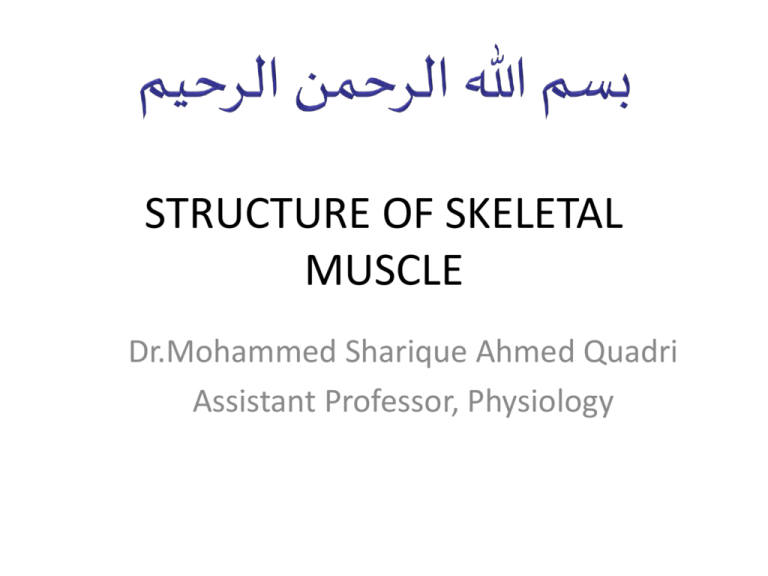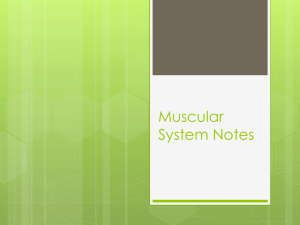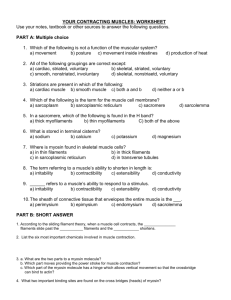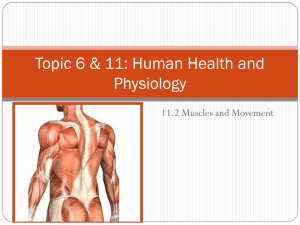Structure of Skeletal Muscle
advertisement

STRUCTURE OF SKELETAL MUSCLE Dr.Mohammed Sharique Ahmed Quadri Assistant Professor, Physiology Objectives By the end of this lecture, you should be able to: Draw and label a skeletal muscle at all anatomical levels, from the whole muscle to the molecular components of the sarcomere. At the sarcomere level, include at least two different stages of myofilament overlap. Diagram the structure of the thick and thin myofilaments and label the constituent proteins. Describe the functional importance of the subunits. Categorization of Muscle Structure of Skeletal Muscle • Skeletal muscle consists a number of muscle fibers lying parallel to one another and held together by connective tissue • Single skeletal muscle cell is known as a muscle fiber – Multinucleated – Large, elongated, and cylindrically shaped – Fibers usually extend entire length of muscle Structure of skeletal muscle Structure of Skeletal Muscle • Myofibrils – Contractile elements of muscle fiber – Regular arrangement of thick and thin filaments • Thick filaments – myosin (protein) • Thin filaments – actin (protein) Viewed microscopically myofibril displays alternating dark (the A bands) and light bands (the I bands) giving appearance of striations Structure of Skeletal Muscle • Sarcomere – Functional unit of skeletal muscle – Found between 2 Z lines (connects thin filaments of two adjoining sarcomeres) – Regions of sarcomere • A band – Made up of thick filaments along with portions of thin filaments that overlap on both ends of thick filaments • H zone – Lighter area within middle of A band where thin filaments do not reach • M line – Extends vertically down middle of A band within center of H zone • I band – Consists of remaining portion of thin filaments that do not project into A band Cytoskeleton components of myofibril Myosin • Component of thick filament • Protein molecule consisting of two identical subunits shaped somewhat like a golf club – Tail ends are intertwined around each other – Globular heads project out at one end • Tails oriented toward center of filament and globular heads protrude outward at regular intervals – Heads form cross bridges between thick and thin filaments • Cross bridge has 2 important sites critical to contractile process – An actin-binding site – A myosin ATPase (ATP-splitting) site Structure and Arrangement of Myosin Molecules Within Thick Filament Actin • Primary structural component of thin filaments • Spherical in shape • Thin filament also has 2 other proteins – Tropomyosin – Troponin • Each actin molecule has special binding site for attachment with myosin cross bridge – Binding results in contraction of muscle fiber Composition of a Thin Filament • Actin and myosin are often called contractile Proteins. – Neither actually contracts. • Actin and myosin are not unique to muscle cells, but are more abundant and more highly organized in muscle cells. Tropomyosin and Troponin • Often called regulatory proteins • Tropomyosin – Thread-like molecules that lie end to end alongside groove of actin spiral – In this position, covers actin sites for binding with myosin , blocking interaction that leads to muscle contraction • Troponin – Made of 3 polypeptide units • One binds to tropomyosin • One binds to actin • One can bind with Ca2+ Tropomyosin and Troponin • Troponin – When not bound to Ca2+ • Troponin stabilizes tropomyosin in blocking position over actin’s cross-bridge binding sites – When Ca2+ binds to troponin • Tropomyosin moves away from blocking position – With tropomyosin out of way, actin and myosin bind, interact at cross-bridges • Muscle contraction results Cross-bridge interaction between actin and myosin brings about muscle contraction by means of the sliding filament mechanism. T Tubules and Sarcoplasmic Reticulum Sarcoplasmic Reticulum • Modified endoplasmic reticulum • Consists of fine network of interconnected compartments that surround each myofibril • Not continuous but encircles myofibril throughout its length • Segments are wrapped around each A band and each I band – Ends of segments expand to form saclike regions – lateral sacs (terminal cisternae) Transverse Tubules • T tubules • Run perpendicularly from surface of muscle cell membrane into central portions of the muscle fiber • Since membrane is continuous with surface membrane – action potential on surface membrane also spreads down into T-tubule • Spread of action potential down a T tubule triggers release of Ca2+ from sarcoplasmic reticulum into cytosol Relationship Between T Tubule and Adjacent Lateral Sacs of Sarcoplasmic Reticulum References • Human physiology by Lauralee Sherwood, 7th edition • Text book physiology by Guyton &Hall,12th edition • Text book of physiology by Linda .s contanzo,third edition 24







